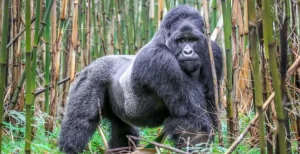Conservation History in Uganda
Conservation history in Uganda involves saving and ensuring the sustainable use of Uganda’s diverse natural resources of future generations. Conservation in Uganda is not a new thing but dates back to the British Colonial period (in the early 20th Century) and still plays a tremendous role in shaping the country’s political economy as it also forms part of the tourism sector that contributes a fifth of Uganda’s total exports.
 The collaborative Conservation and Management of Uganda’s wildlife in the Uganda Protectorate started in the 1920s (1923 to be precise) with the establishment of the Elephant Control Department. The main goal of this Department was to minimize destruction to peasant agriculture by placing a limit on the size and range of elephant populations whereby culling programs killing over 1000 elephants every year.
The collaborative Conservation and Management of Uganda’s wildlife in the Uganda Protectorate started in the 1920s (1923 to be precise) with the establishment of the Elephant Control Department. The main goal of this Department was to minimize destruction to peasant agriculture by placing a limit on the size and range of elephant populations whereby culling programs killing over 1000 elephants every year.
There are over 60 Conservation Protected Areas in Uganda that shelter a number of endangered, critically endangered, threatened and endemic species. There are so far 10 National Parks in Uganda that include Murchison falls, Kidepo Valley, Queen Elizabeth, Mount Elgon, Semliki Valley, Kibale Forest, Mgahinga Gorilla, Lake Mburo, Rwenzori Mountains and Bwindi Impenetrable National Parks while Wildlife Reserves in the country are Aswa-Lolim, Bokora Corridor, Ajai, Toro-Semliki, Matheniko, Pian Upe, Katonga and Bugungu Wildlife Reserves and Ziwa Rhino Sanctuary being one of the most popular Sanctuaries in the country.
In Uganda, the Uganda Wildlife Authority (UWA) is responsible for conserving the country’s rich natural heritages that ranges from plants, animals, natural features to their overall ecosystems. Uganda Wildlife Authority applies several approaches in the Conservation and sustainable management of Uganda’s wildlife species which include Conservation education and awareness, Problem animal management, involving communities in wildlife management, wildlife use rights, collaborative management of resources and revenue sharing Schemes among others. In so doing, the main conservation challenges including illegal grazing, poaching and encroachment are addressed.
Uganda Wildlife Authority also conducts patrols within all the Protected Areas and arrests people that encroach or access Park land without Authorization from the Authority. UWA also works with local communities living around Protected Areas to offer solutions to human-wildlife conflicts and problems animals among others in addition to supporting wildlife benefit sharing schemes that are aimed at contributing towards the attainment of the Government’s goal of eradicating poverty as well as improving livelihoods of communities.
The Uganda Wildlife Authority doesn’t work alone in conserving natural resources in Uganda but works jointly with several International agencies. Wildlife Conservation Society (WCS) is one of the most popular International Agencies working towards Conservation in Uganda, having started its work through carrying out biological surveys of the country’s Savannah National Parks in 1957. From that time, the Agency has continuously offered funds for conservation works despite the turbulent regime of Idi Amin Dada.
Wildlife Conservation Society has also been active in supporting the Conservation of Kibale Forest in the 1970s and 1980s, in addition to playing an important role towards its establishment into a National park in 1993. It has been instrumental in building research and management capabilities of Ugandans by funding student research projects as well as developing the Institute of Tropical Forest Conservation (ITFC) and training to Uganda Wildlife Authority and National Forest Authority (NFA) rangers/staff.
Uganda, also referred as the Pearl of Africa is a haven to more than 350 species of mammals ranging from the larger ones such as the famous Mountain gorillas to the smaller ones like rats, over 1041 species of birds (10% of the World’s species of birds) including the rare shoebill storks, over 140 butterfly species and more than reptile species among others.
